Physical Address
304 North Cardinal St.
Dorchester Center, MA 02124
Thrombolytic therapy remains the preferred reperfusion strategy in patients with ST-elevation myocardial infarction (STEMI) who present within 12 hours of symptom onset when timely primary percutaneous coronary intervention (PCI) is not available and no contraindications to thrombolysis are present.
Adjunctive antiplatelet and antithrombotic therapies are critical to the maintenance of epicardial vessel patency and to the reduction of downstream microvascular obstruction in patients treated with thrombolytics, and they offer proven survival benefits.
The routine use of thrombolytics as adjunctive therapy in primary PCI is not supported by clinical evidence and should generally be avoided.
Early routine coronary angiography and PCI following primary thrombolytic therapy for STEMI should be performed in all high-risk patients, and it should be considered in all patients following successful thrombolysis.
Despite the growing availability of primary PCI, thrombolytic therapy will be the most common and important reperfusion strategy for STEMI given the growing burden of cardiovascular disease worldwide, particularly in developing nations.
Atherosclerotic plaque rupture with subsequent thrombus formation through an intricate series of interactions among the coronary artery endothelium, exposed subendothelium, circulating platelets, and coagulation factors that lead to occlusion of an epicardial coronary artery are the pathophysiologic underpinnings of ST-elevation myocardial infarction (STEMI). The “open artery” hypothesis postulates that early reperfusion of the occluded artery translates into myocardial salvage and ultimately improved survival, and this is the basis of reperfusion therapy. The evidence for the benefit of thrombolytic therapy as a reperfusion strategy in STEMI is indisputable. Pivotal placebo-controlled randomized trials of patients with STEMI from the 1980s, beginning with the Gruppo Italiano per lo Studio della Sopravvivenza nell’Infarto Miocardico (GISSI) study and the Second International Study of Infarct Survival (ISIS-2), proved the value of early thrombolysis by reducing mortality by approximately 30% ( Table 12.1 ). These studies catalyzed the acceptance of thrombolysis as standard therapy for reperfusion in patients with acute myocardial infarction (AMI) and ushered in the thrombolytic era , a term that characterized the revolution in attitude among the medical community toward this disease. Although primary percutaneous coronary intervention (PCI) has superseded thrombolysis as the preferred reperfusion strategy in most patients presenting with STEMI, the most recent American College of Cardiology Foundation/American Heart Association (ACCF/AHA) STEMI guidelines continue to favor thrombolytic therapy over primary PCI as the primary reperfusion strategy in patients who (1) present within 12 hours of symptom onset, (2) have no invasive option (i.e., a catheterization laboratory is unavailable, vascular access issues are present) or face a delay of more than 120 minutes from first medical contact to primary PCI, (3) are not in cardiogenic shock, and (4) have no contraindications to thrombolytic therapy ( Table 12.2 ). However, because of concerns about bleeding complications, incomplete patency, and early reocclusion rates with thrombolytic therapy—combined with the fact that more primary PCIs are safely and successfully being performed at smaller hospitals without on-site cardiac surgery backup—thrombolytic therapy has been surpassed by primary PCI as the treatment modality for STEMI associated with better clinical outcomes ( Fig. 12.1 ). Whereas PCI has evolved into the preferred reperfusion strategy, particularly at high-volume experienced centers, it is not universally available. From 2003 to 2011 there was a 21% increase in PCI centers in the United States; however, most of this growth has occurred in population centers that already had preexisting PCI facilities. Only 79.9% of the U.S. population lived within a 60-minute drive of a PCI-capable hospital in 2006. Though the door-to-balloon (DTB) time has decreased significantly over the past few years with a median time of 96 minutes in 2005 down to 64 minutes in 2010, 9% of patients still had a DTB time greater than 90 minutes. These two points indicate that a substantial number of patients still experience an inordinate delay in mechanical reperfusion therapy in current practice. This was further evidenced by a cohort study of 68,439 patients who presented to PCI-capable hospitals with STEMI between 1999 and 2002, which suggested that most STEMI patients received reperfusion therapy (68.7% PCI and 54.2% fibrinolysis) during off hours (weekdays 5 p.m. to 7 a.m. and weekends) and that these patients experienced significant delays in PCI but not in thrombolytic therapy. Moreover, De Luca and colleagues showed that every 30 minutes of delay in primary PCI results in a 7.5% increase in 1-year mortality. Therefore, thrombolytic therapy remains an important tool in the therapeutic armamentarium for treating STEMI, albeit with significant limitations. This chapter reviews the historic basis of thrombolytic intervention, summarizes current thrombolytic agents and adjunctive therapies, and highlights the evidence for its current role in reperfusion therapy for STEMI, laying the groundwork for future progress in this field.
| Trial (n) | No. of Sites | Agent | Dose/Duration | Enrollment Dates | Placebo/Blinding | Age Criteria (Years) | Symptom Duration (h) |
|---|---|---|---|---|---|---|---|
| GISSI-1 (11,806) | 176 | SK | 1.5 MU/1 h | 2/84–6/85 | No | All | <12 |
| ISIS-2 (17,187) | 417 | SK | 1.5 MU/1 h | 3/85–12/87 | Yes | All | <24 |
| AIMS (1,258) | 39 | APSAC | 30 U/5 min | 9/85–10/87 | Yes | <75 | <6 |
| ASSET (5,011) | 52 | tPA | 100 mg/3 h | 11/86–2/88 | Yes | <75 | <6 |
| Absolute Contraindications |
|
| Relative Contraindications |
|
a This table should be used only for assistance in clinical decision making and may not be all inclusive.
![Fig. 12.1, Odds ratios (95% confidence interval) of short-term death (A), nonfatal reinfarction (B), and combined death, nonfatal reinfarction, and stroke (C) for patients treated with percutaneous coronary intervention (also known as percutaneous transluminal coronary angioplasty [PTCA] ) versus thrombolytic therapy for ST-elevation myocardial infarction. Fig. 12.1, Odds ratios (95% confidence interval) of short-term death (A), nonfatal reinfarction (B), and combined death, nonfatal reinfarction, and stroke (C) for patients treated with percutaneous coronary intervention (also known as percutaneous transluminal coronary angioplasty [PTCA] ) versus thrombolytic therapy for ST-elevation myocardial infarction.](https://storage.googleapis.com/dl.dentistrykey.com/clinical/ThrombolyticIntervention/0_3s20B978032356814200012X.jpg)
Thrombolytic therapy was born in 1933, when Tillett and Garner described the fibrinolytic activity of β-hemolytic streptococci, which led to the first therapeutic attempt by Tillett and Sherry in 1948 to dissolve a fibrinous pleural effusion. Over 20 years later, in 1971, the results of the first randomized controlled trial demonstrating the benefit of thrombolytic therapy using streptokinase in AMI were published. In 1981, Rentrop and colleagues showed that intracoronary streptokinase was effective in the lysis of coronary thrombi with the use of coronary angiography, and Markis and coworkers demonstrated myocardial salvage with the same therapy, thus providing proof of the validity of the concept. Shortly thereafter, human tissue plasminogen activator (tPA) was isolated from a melanoma cell line and was demonstrated to be effective in reducing mortality in AMI. Current thrombolytic therapy comprises a class of agents known as plasminogen activators , which directly or indirectly convert the proenzyme plasminogen into plasmin. Plasmin is a nonspecific serine protease that catalyzes the degradation of fibrin, fibrinogen, prothrombin, and factors V and VII, thus disrupting the coagulation cascade and thrombus generation. Plasminogen activators include the fibrin-specific agents such as alteplase (tPA), single-chain urokinase plasminogen activator (scu-PA), tenecteplase (TNK), and staphylokinase (SAK)—which enzymatically converts plasminogen into plasmin—as well as the non–fibrin-specific agents such as streptokinase , anistreplase (anisoylated plasminogen streptokinase activator complex [APSAC]), urokinase , reteplase (recombinant plasminogen activator [r-PA]), and lanoteplase (novel plasminogen activator [n-PA]) which have intermediate fibrin specificity. Currently, four thrombolytic agents are approved for use by the U.S. Food and Drug Administration (FDA) and are used most commonly worldwide: streptokinase , alteplase , reteplase , and tenecteplase . The last three agents were developed via recombinant deoxyribonucleic acid (DNA) technology to improve fibrin specificity and to increase the duration of activity to enable bolus dosing. The major thrombolytic agents are briefly reviewed with regard to mechanism of action and thrombolytic profile ( Table 12.3 ). Several novel fibrin-specific agents, monteplase (MT-PA), palmiteplase (YM866), amediplase (K[2] tu-PA), and forteplase (recombinant nonimmunogenic staphylokinase)—as well as a novel thrombin-activated plasminogen analogue, BB-10153, which would theoretically be activated only at the site of a developing thrombus—were evaluated in preclinical studies and small-scale human trials, but the efficacy of these agents has yet to be evaluated in larger phase III studies.
| Streptokinase | Tenecteplase | Alteplase | Reteplase | |
|---|---|---|---|---|
| Source | Group C streptococci | Recombinant, human | Recombinant, human | Recombinant, human mutant tPA |
| Molecular weight (kDa) | 47 | 57 a | 63 to 70 | 39 |
| Fibrin specificity | No | Yes | Yes | Yes |
| Metabolism | Hepatic | Hepatic | Hepatic | Renal |
| Half-life (min) | 18–23 | 20–24 | 3–4 | 14 |
| Mode of action | Activator complex | Direct | Direct | Direct |
| Antigenicity | Yes | No | No | No |
| Estimated hospital cost per dose (USD) b | $300/1.5 MU | $2200 | $2200/100 mg | $2200/20 MU |
a Turcasso NM, Nappi JM. Tenecteplase for treatment of acute myocardial infarction. Ann Pharmacother . 2001;35(10):1233–1240.
The GISSI-2/International trial with 20,891 patients with STEMI within 6 hours of symptom onset randomly assigned to either alteplase or streptokinase demonstrated no difference in mortality between streptokinase and alteplase with or without subcutaneous heparin (intravenous [IV] heparin was rarely used in this trial) but showed a higher rate of ischemic stroke in the alteplase group. The ISIS-3 trial with 41,299 patients randomized to alteplase, streptokinase, or anistreplase demonstrated equivalence in mortality reduction among the three agents but found that streptokinase was associated with the lowest overall rates of stroke (1.1%) and intracerebral hemorrhage (0.3%). IV heparin was not used in this trial; however, it has been borne out collectively through other studies of the fibrin-specific plasminogen activators that adjunctive heparin, although not critical to achieve thrombolysis, is important to sustain infarct vessel patency through the avoidance of recurrent thrombosis. The Global Utilization of Streptokinase and Tissue Plasminogen Activator for Occluded Coronary Arteries I (GUSTO-I) trial with 41,021 patients promulgated the benefit of “accelerated” alteplase plus IV heparin in STEMI, leading to a 15% relative and 1% absolute reduction in mortality (or 1 life saved per 100 patients treated). This study included an angiographic component, which led to the major finding that early and complete infarct vessel patency was tightly linked to a reduction in mortality. The Reteplase (r-PA) Angiographic Phase I International Dose-Finding Study (RAPID-I) suggested a nonsignificant 30-day mortality benefit with reteplase compared with alteplase (1.9% vs. 3.9%), and the RAPID-II trial showed a significant improvement in coronary artery patency defined as thrombolysis in myocardial infarction (TIMI) grade 2 flow within 90 minutes that favored reteplase over alteplase (85.2% vs. 77.2%, P = .03). The GUSTO-III trial involved 15,021 patients but failed to show true equivalence of reteplase to “accelerated” alteplase, although it demonstrated a trend toward equivalence, especially for death and disabling stroke. These findings, combined with the more convenient double-bolus administration, rendered reteplase a viable option for thrombolysis. The Assessment of the Safety and Efficacy of a New Thrombolytic 2 (ASSENT-2) trial of 16,949 patients randomized to receive either tenecteplase or alteplase found similar mortality rates, but the highly fibrin-specific tenecteplase was notable for significantly less bleeding compared with alteplase. Although this result was tempered by a relatively high rate of intracerebral hemorrhage in both groups, lower rates of overall bleeding (26.1% vs. 28.4%, P < .0003) and blood transfusions (4.3% vs. 5.5%, P = .0002) were observed with tenecteplase compared with alteplase. Currently, thrombolytic agent selection at most hospitals in the United States is guided by hospital formulary and drug availability given the lack of any striking differences in the efficacy or safety of the approved thrombolytic agents.
The degree of myocardial salvage following AMI is clearly related to timely reperfusion, reinforcing the “time is myocardium” principle with the 2- to 3-hour time point representing the critical window to minimize morbidity and mortality ( Fig. 12.2 ). A meta-analysis of six randomized controlled trials of pre-hospital and in-hospital thrombolysis for AMI that included 6434 patients showed reduced time to thrombolysis (104 vs. 162 min, P = .007) and reduced all-cause hospital mortality (odds ratio [OR], 0.83; 95% confidence interval [CI] 0.70 to 0.98) with pre-hospital fibrinolysis. Subsequent randomized trials have reproduced these findings in populations in the United States and in Europe and have demonstrated the feasibility of safe and effective pre-hospital fibrinolysis administered by paramedics. Current ACCF/AHA guidelines for STEMI management recognize the potential benefit of pre-hospital fibrinolysis by appropriately trained personnel, but logistical challenges that include implementation of systems for rapid pre-hospital diagnosis and training of personnel in the appropriate administration of thrombolytic agents and adjunctive therapies have limited the widespread acceptance and adoption of pre-hospital fibrinolysis. Therefore the 2013 ACCF/AHA guidelines for STEMI management endorse the need for further research regarding the implementation of pre-hospital thrombolysis but stop short of recommending its use.
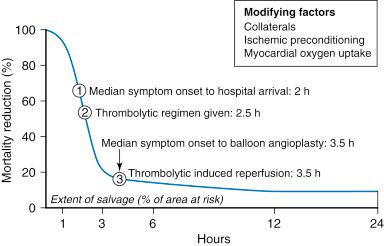
There appears to be an early and sustained difference in favor of primary PCI versus thrombolysis as a function of time to reperfusion. A pooled analysis of 22 randomized clinical trials that included 6763 patients with STEMI who presented within 12 hours of symptom onset showed a 37% reduction in 30-day mortality (adjusted OR 0.63; 95% CI, 0.42 to 0.84) in patients randomized to primary PCI compared with those randomized to thrombolysis regardless of presentation delay up to 12 hours or a PCI-related delay up to 2 hours ( Fig. 12.3 ). Furthermore, the absolute mortality reduction in the PCI group increased from 1.3% in those who presented within an hour after symptom onset to 4.2% for those who presented 6 to 12 hours after symptom onset. Primary PCI is also superior to both pre-hospital and in-hospital thrombolysis with regard to 30-day mortality, 1-year mortality, reinfarction, and myocardial salvage. In addition, long-term follow up of the Swedish Early Decision Reperfusion Strategy (SWEDES) trial showed that the benefit of primary PCI over fibrinolysis with respect to cardiac death or recurrent AMI persisted out to 5 years (hazard ratio [HR] 0.40; 95% CI, 0.19 to 0.82). Even if transfer to another facility is required, the benefit of PCI over thrombolysis with regard to the combined reduction in death, reinfarction, and disabling stroke at 30 days (driven primarily by reinfarction) is sustained in those patients with STEMI who present within 12 hours of symptom onset. Furthermore, in the referral hospital substudy of the Danish Trial in Acute Myocardial Infarction 2 (DANAMI-2), patients with STEMI transferred to a PCI-capable hospital for primary PCI within 120 minutes had improvements in reinfarction (13% vs. 18.5%, HR 0.66; 95% CI, 0.49 to 0.89) and mortality (26.7% vs. 33.3%, HR 0.78; 95% CI, 0.63 to 0.97) out to 8 years of follow-up. However, the net benefit of primary PCI over thrombolysis may be neutralized if the DTB time for PCI is 60 minutes longer than door-to-needle (DTN) time for thrombolysis, given that every 30-minute delay in the interval from symptom onset to balloon inflation is associated with a 7.5% increased risk of death at 1 year. Hence the 2013 ACCF/AHA STEMI guidelines recommend that in-hospital thrombolytic therapy should be administered to those patients who present to a non–PCI-capable hospital within 12 hours of symptom onset if transfer for primary PCI (the preferred reperfusion strategy) cannot be completed in a timely fashion—that is, time from arrival at the non–PCI-capable hospital to leaving for the PCI-capable hospital (door-in-door-out [DIDO] time) of 30 minutes or less or anticipated first medical contact to device time of 120 minutes of less—and there is no evidence of severe heart failure or cardiogenic shock ( Fig. 12.4 ).
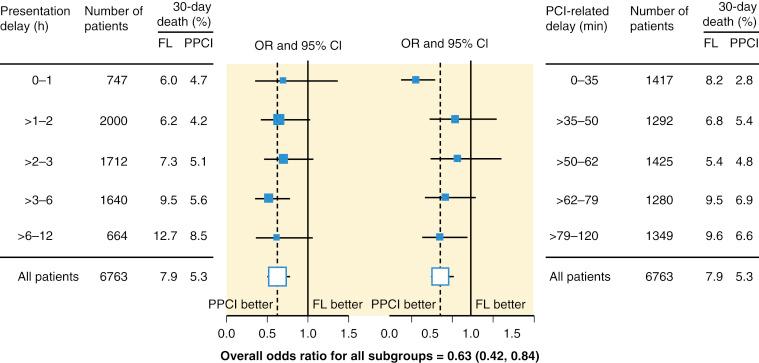
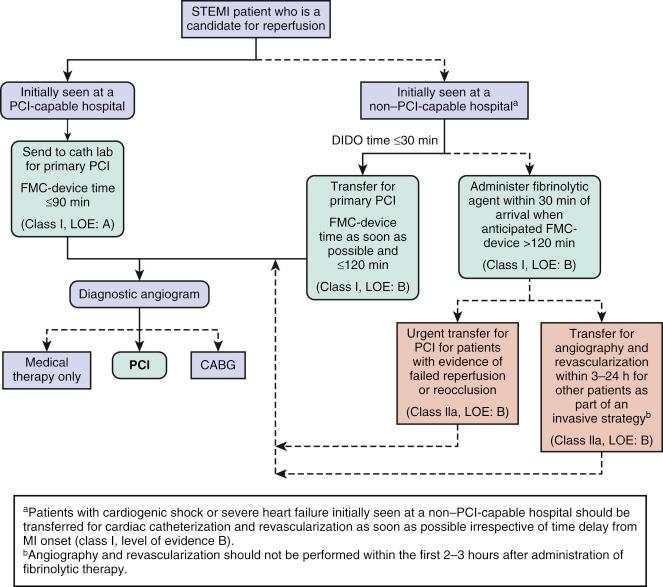
In 30% to 40% of patients who fail thrombolysis (<70% ST-segment resolution at 90 min or ongoing chest pain), rescue PCI should be performed, given the benefit of this strategy ( Fig. 12.5 ). Accumulating evidence also supports the benefit of performing routine cardiac catheterization and PCI within 24 hours or earlier regardless of the success of thrombolysis ( Fig. 12.6 ). This pharmacoinvasive approach is discussed in more detail later in this chapter. The facilitated PCI approach, with early administration of a thrombolytic agent in anticipation of mechanical revascularization, is also discussed later in this chapter.
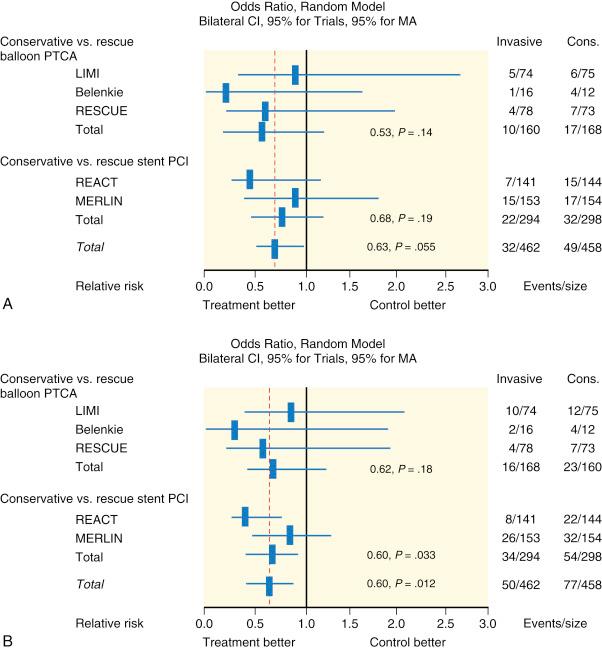
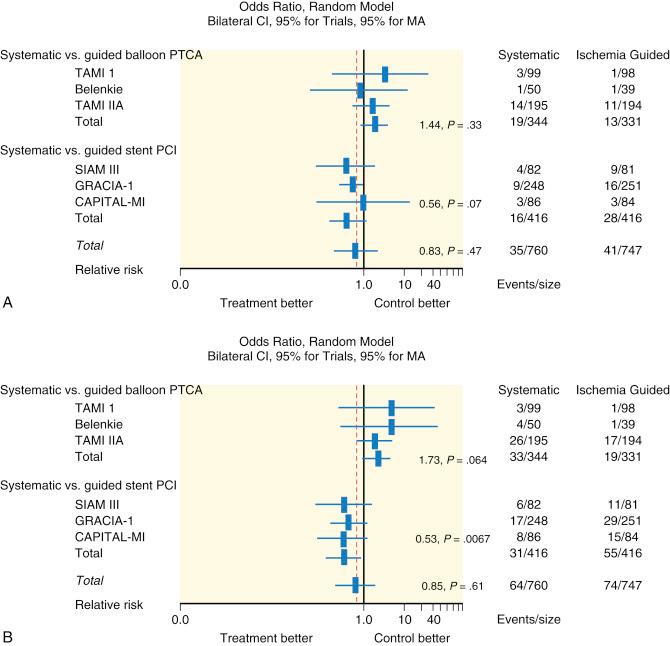
Become a Clinical Tree membership for Full access and enjoy Unlimited articles
If you are a member. Log in here